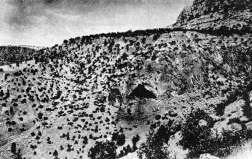|
Other Archaeological Sites / The Neolithic of the Levant (500 Page Book Online) Pre-Historic Zawi Chemi Shanidar Selected Excerpt on Zawi Chemi Shanidar Palaeolithic Shanidar Cave
Epi-Palaeolithic Zawi Chemi Shanidar A site of the Karim Shahir Culture near the Zab River in northern Iraq 6 kilometres from the Shanidar Cave. This open air site provides important evidence of early stock control associated with a radiocarbon date of circa 8640 BC. High proportions of immature sheep, especially in the upper levels, were originally interpreted as indicating incipient domestication but today this evidence is more often taken to indicate stock manipulation, perhaps herding, rather than domestication. Occupation was probably seasonal and plant resources were clearly exploited as indicated by the occurrence of querns, grinding stones and storage pits. Other artefacts include stone axes and non-utilitarian objects such as worked bone with incised or notched decoration. Obsidian from the Lake Van area of Anatolia indicates far ranging contacts. The site also produced remains of a circular stone structure, perhaps a hut, and 28 burials, 26 of which were associated with a stone platform ... (AHSFC) |
